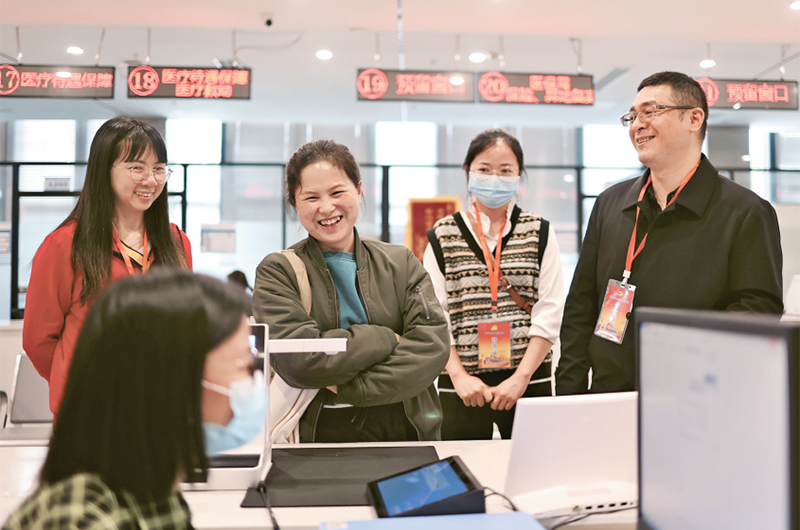Cultural Context and Huazhang丨From "preserving" to "living up" and guarding the Chinese cultural context and Chinese civilization with the General Secretary | Xi Jinping | Huazhang
Using literature to forge soul, how can China’s historical context continue? To promote industry through literature, how can cultural inheritance be innovatively developed?
"Chinese-style modernization gives Chinese civilization modern power, and Chinese civilization gives Chinese-style modernization a profound foundation." On June 2 last year, at the symposium on cultural inheritance and development, General Secretary Xi Jinping expressed his views on China from the overall strategic perspective of the development of the party and the country's undertakings. A series of major theoretical and practical issues in cultural inheritance and development are comprehensively and systematically elaborated on.
Over the past year, Xi Jinping visited ancient cities, explored the cultural context, and looked at intangible cultural heritage, constantly searching for the answer to "Why China" of the times, and leading China on the road of cultural inheritance.
Tianjin Ancient Culture Street, known as the "Hometown of Tianjin", is the earliest economic, cultural, and commercial gathering place in Tianjin.
On the afternoon of February 1, 2024, while inspecting Tianjin Ancient Culture Street, Xi Jinping interacted with store employees and people on site. Photo by reporter Xie Huanchi
On the afternoon of February 1 this year, Xi Jinping came to Tianjin Ancient Culture Street and walked into specialty shops such as Mahua, Nut Zhang, Clay Figure Zhang, and Yangliuqing Painting on Guifaxiang 18th Street to learn about product types, sales, and the inheritance and development of traditional culture. .
During the inspection, Xi Jinping pointed out that Chinese-style modernization is inseparable from the inheritance and promotion of excellent traditional culture. Tianjin is a city with great characteristics and charm. It is necessary to protect and make good use of historical and cultural blocks to make them shine in the construction of a modern metropolis. .
Tianjin has preserved a large number of unique modern architectural clusters and historical and cultural blocks. Protecting Tianjin’s unique Tianjin culture is a mission given by the times.
On January 17, 2019, while inspecting the Beijing-Tianjin-Hebei region, Xi Jinping came to Liang Qichao’s former residence and listened to an introduction to the protection of Tianjin’s historical and cultural blocks based on the exhibition boards. He pointed out that we should cherish the city's historical and cultural heritage, develop while protecting, and protect while developing.
Customers watch a performance at a time-honored store in Tianjin. Photo by reporter Zhao Zishuo
Institutional guarantee - Prepare the "Tianjin Historical and Cultural City Protection Plan" to form an overall protection structure of "one city, two districts, two belts, and multiple points"; issue normative documents such as the "Tianjin Historical and Style Building Protection Regulations" to further improve Policy and regulatory system for the protection of historic buildings.
Innovation and empowerment - adhere to market-oriented operations, realize the renewal and improvement of historical and cultural blocks, and explore the formation of a "historic style architecture" model. At the same time, we promote the deep integration of cultural and tourism formats, markets and products, inject new vitality into old buildings, continue new stories and bring new popularity.
Cross-border integration - continue to expand consumption scenarios, create parallel reality digital immersion projects, create a high-standard IP matrix for historical and cultural blocks, and build a digital cultural tourism online and offline co-creation platform.
An ancient street and historical and cultural heritage everywhere connect the past, present and future, and contain the cultural code of Chinese modernization.
Changde River Street, located on the bank of the Yuanjiang River, has a long history and was destroyed in the 1943 Battle of Changde. In recent years, Changde City has restored the style of Laohe Street and turned it into a historical and cultural district.
On the morning of March 19, 2024, Xi Jinping had cordial exchanges with shopkeepers and tourists during an inspection on Changde River Street. Photo by reporter Wang Ye
On March 19 this year, Xi Jinping came here to inspect various special snacks, specialties, and special handicrafts, communicate with shopkeepers and tourists cordially, appreciate the display of intangible cultural heritage skills, and learn more about the restoration and utilization of Changde Old City streets, urban planning, Comprehensive management of water environment, etc.
Strolling along Changde River Street, a giant ink original design caught Xi Jinping's attention.
This work is the wood carving design created by Pan Nenghui, the intangible inheritor of Pan's art wood carving, based on Shen Congwen's famous book "Xiang Xing Ji". He plans to use 10 years to restore it to a 10-meter-long giant red toon On the gloomy wood.
"The colorful traditional culture with local characteristics together constitute the splendid Chinese civilization and also promote economic and social development." Xi Jinping pointed out during an inspection at Changde River Street that Changde is a place with cultural heritage. The silk strings, high tunes and chants here It must be passed down and utilized through appropriate carriers and developed with the times.
Pan Nenghui and his wife Hu Meihua display wood carvings on He Street in Changde, Hunan. Photo by reporter Xue Yuge
How to revitalize intangible cultural heritage in the new era?
In recent years, Changde has worked hard to explore new cross-border, cross-domain and cross-industry models of "intangible cultural heritage", "intangible cultural heritage education" and "intangible cultural heritage technology", attracting more than 50 intangible cultural heritage teams such as Taoyuan embroidery, hemp painting and Changde wood carving. Changde River Street creates a situational and immersive multicultural experience, allowing the national intangible cultural heritage to be integrated into the daily lives of citizens and tourists.
At present, there are more than 100,000 representative intangible cultural heritage projects at all levels in our country, more than 90,000 representative inheritors of intangible cultural heritage at all levels, and more than 6,700 intangible cultural heritage workshops.
Intangible cultural heritage projects are based on human inheritance, and generations of inheritors continue to make the cultural carrier more vivid.
The Great Wall is my country's largest existing cultural heritage and a window for the world to experience and understand Chinese civilization.
On May 14 this year, Xi Jinping replied to the villagers in Shixia Village, Badaling Town, Yanqing District, Beijing, profoundly explaining the unique value of the Great Wall and the great significance of protecting the Great Wall.
"I hope that everyone will continue to work hard and make contributions over a long period of time, protect the Great Wall like you protect your home, promote the culture of the Great Wall, tell the stories of the Great Wall well, drive more people to understand the Great Wall, protect the Great Wall, and pass on this precious wealth left by our ancestors from generation to generation. Go on and contribute to building a strong socialist cultural country and promoting Chinese-style modernization.”
In 2019, Xi Jinping presided over the ninth meeting of the Central Committee for Comprehensive Deepening Reforms, which reviewed and approved the "Construction Plan for the Great Wall, Grand Canal, and Long March National Cultural Park"; in 2021, the "Construction and Protection Plan for the Great Wall National Cultural Park" was issued, proposing to focus on Build the Great Wall National Cultural Park into an important symbol for carrying forward the national spirit and inheriting Chinese civilization.
In recent years, we have organized and implemented resource surveys and cleaned up the Great Wall protection assets; established a legal system with the "Great Wall Protection Regulations" as the main body and local special regulations as the support; continued to promote the protection of the Great Wall itself, and successively approved 289 Great Wall protection and maintenance projects; and increased inspections. Strengthen efforts to protect the "last mile" of the Great Wall... The protection and inheritance of the ancient Great Wall has ushered in a new chapter.
To protect the Great Wall, we must also promote the culture of the Great Wall, tell the story of the Great Wall and tell the story of China well.
The frontier fortress epic drama "The Grand Pass" brings a visual feast, the Great Wall tourism resources lead the way to wealth, and research activities continue to be carried out... Various fields rely on the cultural resources of the Great Wall to develop according to local conditions, and continue to write a new era of cultural heritage protection.
At present, my country has a total of 43 world cultural heritages, world cultural and natural dual heritages, and 43 world intangible cultural heritages. They are scattered across the beautiful land, continuing to explore the path of activation and inheritance.
——Digital empowerment makes culture “alive”. "Vibrant Forbidden City", "Panorama Terracotta Warriors and Horses" and "Dunhuang Tour" have been launched one after another, and AI algorithms have realized the restoration of cultural relics and naked-eye 3D restoration of archaeological sites.
——Innovation and integration make culture “popular”. The Yue opera "New Longmen Inn", the dance dramas "A Night Banquet at the Tang Palace" and "Only Green", and the movie "30,000 Miles from Chang'an" are frequent hits; tickets for cultural and museum attractions such as the Forbidden City in Beijing and the Mogao Grottoes in Dunhuang are hard to come by. "Museums in a City" is becoming more and more popular.
Today's China uses the unique language of Chinese culture to show the world the cultural charm of the ancient Eastern civilization.
"Continuing to promote cultural prosperity, build a cultural power, and build the modern civilization of the Chinese nation from a new starting point is our new cultural mission in the new era." A year ago, Xi Jinping made clear terms for cultural inheritance and development at the symposium on cultural inheritance and development. direction.
Standing in the new era and looking into the future, Xi Jinping solemnly declared: "Chinese-style modernization is the new destiny of the Chinese nation and will surely promote the restoration of Chinese civilization's glory."





